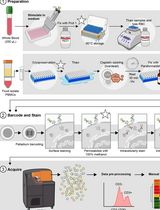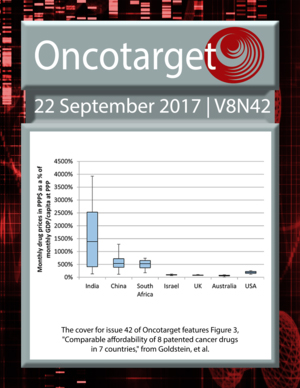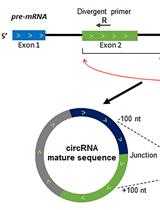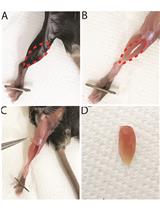- EN - English
- CN - 中文
Protocol for in situ Proximity Ligation Assay (PLA) and Microscopy Analysis of Epidermal Growth Factor Receptor (EGFR) Homodimerization
原位邻位连接检测和显微镜分析表皮生长因子的同源二聚化的实验方法
发布: 2018年11月05日第8卷第21期 DOI: 10.21769/BioProtoc.3067 浏览次数: 8457
评审: Chiara AmbrogioMauro Sbroggio'Anonymous reviewer(s)

相关实验方案

用于比较人冷冻保存 PBMC 与全血中 JAK/STAT 信号通路的双磷酸化 CyTOF 流程
Ilyssa E. Ramos [...] James M. Cherry
2025年11月20日 726 阅读
Abstract
Oncogenic drivers play central roles in tumorigenesis as well as in tumor cell survival and proliferation. Mutations of the epidermal growth factor receptor gene (EGFR) that result in constitutive activation of the receptor tyrosine kinase have been identified as oncogenic drivers in a subset of non-small cell lung cancer (NSCLC). PCR-based assays are usually adopted for the detection of EGFR mutations, but no methods to detect EGFR activation that are not based on mutation identification have been established in the clinical setting. We describe a proximity ligation assay (PLA) used to visualize and quantitate EGFR homodimerization in NSCLC cell lines and tissue specimens. Rabbit monoclonal antibodies against EGFR were conjugated to PLUS or MINUS PLA oligonucleotide arms using Probemaker. Annealing of the PLUS and MINUS PLA probes occurred when two EGFR monomers were in close proximity, and repeat sequences in the annealed oligonucleotide complexes were amplified then recognized by a fluorescently-labeled oligonucleotide probe. PLA signals were detected and counted with a fluorescence microscope. We demonstrate the detection of EGFR homodimers by PLA analysis in a quantitative manner in both NSCLC cell lines and tissue samples obtained by transbronchial lung biopsy. PLA methods are a new tool for the detection and quantitation of protein-protein interactions such as homodimers, heterodimers, and fusion proteins.
Keywords: Oncogenic driver (致癌驱动)Background
Activating mutations of the epidermal growth factor receptor gene (EGFR) are currently detected by PCR-based assays (Nagai et al., 2005). However, the visual detection and quantitation of activated EGFR in the clinical setting has not been established. In situ proximity ligation assay (PLA) is a technology that uses Duolink® In situ reagents (see References 1 and 2) to create probes by conjugating oligonucleotides to antibodies. When two different types of PLA probes (PLUS and MINUS) are in close proximity (40 nm), annealing occurs which generates an amplified circular DNA. The signal from each detected pair of PLA probes is visualized as an individual spot, and the number of PLA signals per cell can be counted with a fluorescence microscope (Figure 1).
The PLA method can be used to detect any protein-protein interactions in close proximity. We have now applied the PLA using primary antibodies derived from the same species to visualize and quantitate EGFR homodimerization. Furthermore, we detected the formation of EGFR-human epidermal growth factor receptor2 heterodimers and echinoderm microtubule-associated protein-like 4-anaplastic lymphoma kinase fusion protein in NSCLC cell lines (Ota et al., 2017). This method will be applicable to the detection of other dimerizations and fusions.
Figure 1. In situ PLA principle for EGFR homodimer. A. PLA probes, created by conjugating PLA oligonucleotides and monoclonal antibodies for EGFR, bind to EGFR. B. Connected oligonucleotides hybridize and create multiple circular DNA molecules. C. Fluorescently-labeled detection of oligonucleotides hybridizing to the DNA circle. (Pictures were taken from the Duolink® In situ User Guide [References 1 and 2]).
Materials and Reagents
- Standard pipette tips with a volume capacity of 10 μl, 20 μl, 100 μl, 200 μl, and 1,000 μl (Thermo Fisher Scientific, catalog numbers: 2140, 2149P, ART 10REACH, ART 20P)
- Kimwipe waste paper sheet S-200 (Crecia, catalog number: 62011)
- 12-mm-diameter uncoated cover glasses (Matsunami Glass, catalog number: C012001)
- 24-well plates (Greiner Bio-One, cell culture multiwell plates, catalog number: 66)
- Staining jar (Matsunami, catalog number: No. 13 BT500)
- Dako Pen (Daido Sangyo, PAP-SPAP Pen Super-Liquid Blocker)
- Serological pipettes
- Slide glasses
- NSCLC cell lines: H1975 cells
- Roswell Park Memorial Institute (RPMI) 1640 medium (Invitrogen, Gibco, catalog number: 61870-036)
- Dulbecco's modified Eagle’s medium (DMEM) (Invitrogen, Gibco, catalog number: 12634010)
- Fetal bovine serum (FBS) (Sigma, catalog number: 14C438FBS)
- Penicillin/Streptomycin solution (Invitrogen, catalog number: 15140122)
- Phosphate-buffered saline (PBS) (LSI, catalog number: RM102-PN)
- 4% paraformaldehyde in PBS (Wako, catalog number: 16320145)
- ImmunoSaver (Wako, catalog number: 9706192)
- Duolink® In situ oligonucleotide PLUS (-20 °C) (Sigma-Aldrich, catalog number: DUO92009)
- Duolink® In situ oligonucleotide MINUS (-20 °C) (Sigma-Aldrich, catalog number: DUO92010)
- Conjugation buffer (-20 °C) (Sigma-Aldrich, catalog number: DUO92009)
- Stop reagent (-20 °C) (Sigma-Aldrich, catalog number: DUO92009)
- Storage solution (-20 °C) (Sigma-Aldrich, catalog number: DUO92009)
- 20x assay reagent (-20 °C) (Sigma-Aldrich, catalog number: DUO92009)
- Blocking solution (4 °C) (Sigma-Aldrich, catalog number: DUO92009)
- PLA probe diluent (4 °C) (Sigma-Aldrich, catalog number: DUO92009)
- Rabbit monoclonal antibodies to EGFR (Abcam, catalog number: ab52894)
- 5x Ligation buffer (-20 °C) (Sigma-Aldrich, catalog number: DUO92008)
- 1x Ligase (-20 °C) (Sigma-Aldrich, catalog number: DUO92008)
- 5x Amplification Red (-20 °C) (Sigma-Aldrich, catalog number: DUO92008)
- 1x Polymerase (-20 °C) (Sigma-Aldrich, catalog number: DUO92008)
- Duolink® In situ mounting medium with DAPI (Sigma-Aldrich, catalog number: DUO82040)
- 10% neutral-buffered formalin
- Paraffin
- Xylene
- Ethanol solutions
- Nail polish
- Culture media (10% FBS) (see Recipes)
- Wash buffer A (Sigma-Aldrich, catalog number: DUO82049, see Recipes)
- Wash buffer B (Sigma-Aldrich, catalog number: DUO82049, see Recipes)
Equipment
- Manual pipettes: set of 10 μl, 20 μl, 100 μl, 200 μl, and 1,000 μl (Mettler Toledo, catalog number: Pipet-Lite XLS+ 17014409, 17014412, 17014408, 17014411, 17014407)
- Tweezers
- Freezer
- Direct-Q® 5 UV Remote Water Purification System (Merck, model: Direct-Q® UV 5 Remote, catalog number: ZRQSVR5WW)
- Autoclave (Tomy, catalog number: LSX-500)
- Vortex mixer (Scientific Industries, model: Vortex-Genie 2, catalog number: S1-0286)
- Humidity chamber (Incubation Chamber, Cosmo Bio, catalog number: 10DO)
- Freeze block for enzymes (-20 °C) (Eppendorf, catalog number: 3880001018)
- Fluorescence microscope (Keyence, model: BZ-8100)
Software
- BZ Analyzer software (Keyence)
- Excel (Microsoft)
- GraphPad Prism 5.0 (GraphPad Software)
Procedure
文章信息
版权信息
© 2018 The Authors; exclusive licensee Bio-protocol LLC.
如何引用
Ota, K. and Harada, T. (2018). Protocol for in situ Proximity Ligation Assay (PLA) and Microscopy Analysis of Epidermal Growth Factor Receptor (EGFR) Homodimerization. Bio-protocol 8(21): e3067. DOI: 10.21769/BioProtoc.3067.
分类
癌症生物学 > 通用技术 > 分子生物学技术
分子生物学 > 蛋白质 > 磷酸化
您对这篇实验方法有问题吗?
在此处发布您的问题,我们将邀请本文作者来回答。同时,我们会将您的问题发布到Bio-protocol Exchange,以便寻求社区成员的帮助。
提问指南
+ 问题描述
写下详细的问题描述,包括所有有助于他人回答您问题的信息(例如实验过程、条件和相关图像等)。
Share
Bluesky
X
Copy link










